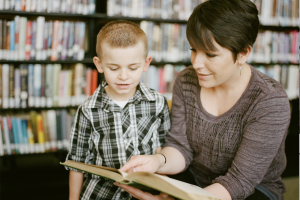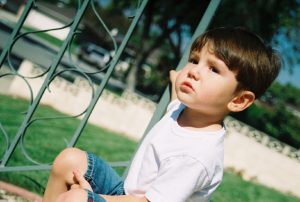Helping Children Thrive: How I Spoke Up for One Little Girl
 When I first met Rikki in the parking lot of a Motel 6, she effortlessly captured my heart. I had actually started to care about her even before that first meeting. As a Court Appointed Special Advocate (CASA) volunteer preparing for my first case, I had read Rikki’s file. I knew she was 10, she was the third of five kids who had been removed from their mother due to neglect and drug abuse, and this was the third time she had been through this kind of upheaval in her short life. I knew that her father had died a year before. He had also been an addict, and like her mother, had been in and out of recovery.
When I first met Rikki in the parking lot of a Motel 6, she effortlessly captured my heart. I had actually started to care about her even before that first meeting. As a Court Appointed Special Advocate (CASA) volunteer preparing for my first case, I had read Rikki’s file. I knew she was 10, she was the third of five kids who had been removed from their mother due to neglect and drug abuse, and this was the third time she had been through this kind of upheaval in her short life. I knew that her father had died a year before. He had also been an addict, and like her mother, had been in and out of recovery.
A few months earlier, after a loss in my own life, I was looking for a way to match my time, energy and caring with a child or children in need. I didn’t know in what capacity…I just knew I was interested in helping children. While interviewing a young woman for a job, she mentioned her volunteer experience as a CASA. That serendipitous encounter led me to find Court Appointed Special Advocates in my town, where I subsequently completed 30 hours of training and a background check, and was sworn in as an officer of the court. The juvenile court judge asked us CASA volunteers to be his “eyes and ears” in the lives of kids in the child welfare system. I didn’t know then the power we were being given to alter these young people’s trajectories, to help them toward better, happier and healthier futures.
My CASA supervisor had handed me several files to read, each one revealing the story of a child who had been abandoned or neglected or abused. She told me I would “just know” which child was the right match for me. Sure enough, Rikki plucked my heartstrings from the page.
As I walked across the Motel 6 parking lot, Rikki came around the corner, and I was surprised by how small and delicate she looked. Within moments, I discovered that this waif-like sprite had the intellect and sense of humor of someone much older. Rikki didn’t look straight into my eyes much on that first outing, but she disarmed me with her observations, and she made me laugh a lot. It was our first visit of many over the next seven years.
When a child gets admitted into the swirl of the foster system, she often goes from being under cared-for by one or two adults to having myriad concerned individuals in her life. In a one-month period, she might interface with a social worker, a lawyer, foster parents, foster siblings, teachers, physician, psychiatrist, and a therapist, not to mention biological parents and biological siblings. In spite of this abundance of interactions, there isn’t one person who is overseeing it all, who knows everything that’s happening in her life, and who is committed to speaking up for her. This is the job of a CASA volunteer.
In 1977, a juvenile court judge in Seattle, aware of the tremendous responsibility of his position and the lack of objective fact-finding in the system, had the brilliant idea of recruiting citizens to advocate on behalf of the abused and neglected children in foster care. In a 2007 issue of The Connection Magazine, Judge David Soukup wrote about his idea, “I never got a night’s sleep without waking to wonder if at least one decision I made that day had been the best for a child. It struck me that it might be possible to recruit and train volunteers to investigate a child’s case so they could provide a voice for the child in those proceedings, proceedings which could affect their whole lives.” Judge Soukup’s idea launched a volunteer effort that materialized as the first CASA program, called the King County Guardian ad Litem Program. By 1983, 28 other states were also helping children through CASA programs.
Kim Colby Davis was a CASA volunteer before she became the Executive Director of CASA of Santa Barbara County in 2009. She knows first-hand the impact a CASA volunteer can have on a child. She told me about Alex, who was abandoned by his parents when he was 11. In foster care, Alex was doing very poorly in school. His new CASA volunteer was the first to speculate that Alex might have vision problems. Sure enough, an examination showed that he needed glasses. After having chronically low grades and thinking of himself as a bad student, Alex shot up academically once his vision was corrected. He is now doing well in college. Another child who benefited from her CASA relationship is Jasmine. She was born to drug addicted parents and assigned a CASA volunteer at birth. With all known factors having been weighed, Jasmine was scheduled to go home with her parents after a short detox period, but a conversation between her CASA volunteer and the pediatrician changed that. The doctor said that Jasmine had the worst case of heroin addiction at birth he had ever seen, and he was adamant that she needed to be placed in a safer situation. Instead of beginning her already fragile life in a home with two at-risk parents, her CASA volunteer made sure that Jasmine got the chance to recover and thrive. She will grow up as the adopted child of people who prayed for the opportunity to be parents.
Stories like Alex’s and Jasmine’s are not rare. The National Court Appointed Special Advocates Association and its affiliate state and local organizations are now helping children in 49 states plus Washington, D.C. These organizations are sometimes known by other names like GAL (for Guardian ad Litem), Voices for Children, or Child Advocates. In all these places, CASA volunteers are making significant differences in the lives of the children they advocate for. National studies show that children who have CASA or GAL volunteers spend less time in foster care – an average of eight months less than kids who don’t have advocates. They are more likely to be adopted and half as likely to reenter foster care. They benefit from more services while in the system, and they do better in school. They are less likely to have poor conduct or be expelled from school, (“Evidence of Effectiveness-National CASA – CASA for Children”, 2017) and more likely to graduate. Kids with CASA volunteers have better outcomes than other kids in the foster system. In Santa Barbara County, the rate of re-abuse goes down very significantly for foster kids who have CASA volunteers. In other words, having a dedicated advocate increases the likelihood that a child will get the best care, the best protection, and the best placement possible.
Rikki has her own story, and being her CASA made it possible for me to play a part in it. When I met her, Rikki was already living with a foster family. She enjoyed regular weekend visits with her mother, stepdad and siblings, but she had a strong, affectionate bond with her foster parents, Beth and Paul. She was stable and doing well in school. She and I got together every week and did fun things, like riding on ‘Lil Toot’ the tugboat in the local harbor, making rock sculptures at the beach, and going to the botanic gardens. She showed me how to lasso a lizard with a long blade of grass, and I bought an annual pass to the zoo, so we could pop over and see the meerkats and gorillas anytime we felt like it. When we drove to and fro, Rikki sat in the backseat and acted out entertaining and perhaps cathartic scenes between a little Buddha and a crystal angel she found in my car, covering a range of topics from drug relapse to super models. We enjoyed lively conversations over lunch. We were regulars at our favorite restaurant, and we smiled at each other when other familiar diners came in and took their habitual tables. We had lots of inside jokes and long-standing games. In the car or walking down the street, we were always competing, on the lookout for out-of-state plates, spontaneously yelling “Wisconsin!” or “Nevada!” As time went on, Rikki would loop her arm through mine when we walked or hold my hand.
As important as our friendship was, my other job was to advocate for Rikki in court. By the time Rikki’s biological mother had been sober for a year and completed all of her court-ordered requirements, she wanted her kids back, and four of them wanted to return to her. But Rikki did not. Rikki felt safe with Beth and Paul; she wanted to stay put. The child protective services system is strongly weighted toward placing kids with their biological parents, absent any clear abuse or neglect. So, if Rikki didn’t have a CASA volunteer, she almost certainly would have been pulled out of her foster home to return to her mother. However, it was my job to speak up for Rikki, and this clear-eyed little girl was unwavering in her desire to stay with Beth and Paul. I pleaded with Rikki’s lawyer to at least petition for extending the foster care. The lawyer acknowledged that it was a long shot but agreed to help me fight. I gathered information from all of the surrogates involved, including a pivotal opinion from Rikki’s psychiatrist. I wrote a report for the judge, detailing all of my findings and strongly recommending that Rikki be allowed to stay with her foster family. I was told by people who had been around the system that this request was unrealistic and would not be fulfilled. But those people were wrong. The judge cared deeply about the kids he had the job of protecting, and apparently Rikki’s lawyer and I conveyed her circumstances thoroughly enough, and her wishes and needs well enough, that he granted them.
Every six months or so, I would go to court to ask that Rikki’s foster care be extended. This was unusual. On average, CASA assignments last about 1.5 years, because most children are either reunited with their parents or permanently placed with a stable guardian within that amount of time. My time as Rikki’s CASA volunteer was extended, because she remained in long-term foster care by choice. We continued with our Saturday visits. Sometimes for a birthday or Christmas, we did something extra special, like go to Universal Studios. With a donation from the community, I got Rikki a look-alike American Girl doll and we took “Kendall” with us on our lunch dates. Rikki loves animals, and I believe the best gift I ever gave her was the Alaskan polar bear I adopted in her name. She was overjoyed, in awe. She cheered and beamed, staring at the “certificate of adoption” and marveling, “I’m a mom. I can’t believe it… I’m a mom.”
Rikki continued to do well in school and to enjoy her relationships with both foster and biological families. Then one day, the summer before she was to enter junior high school, Rikki told me that she wanted to live with her mom again. She was resolute. As her advocate, I trusted her and got on board. All the arrangements were made. As tough as it was to say goodbye to Beth and Paul, Rikki was eager to live with her mom, stepdad, and siblings again. I remained her CASA volunteer for an additional six months, to see her through the transition. When her case was closed, Rikki and I became “regular friends” and for a while we continued to have our Saturday get-togethers. But as her social life expanded in junior high, and her home life changed, we spent less time together, and our communication got sparse.
Drug addiction is a nasty beast, and Rikki’s mother relapsed. The family splintered apart, and eventually, Rikki stayed with friends to avoid the chaos at home. I was no longer her advocate, and I didn’t know about the relapse or Rikki’s predicament until later. What I appreciate so much about Rikki is that she knows how to reach out for help. Ultimately, she found her way back to safety and stability. She was permanently placed with a wonderful guardian, Tanya, and she was assigned a new CASA volunteer. With this support, Rikki finished high school, and she’s now in college. She has a 3.5 GPA and is doing very well in all her classes. When I asked if she would mind me writing about our time together in the CASA program, she said “Honestly, I really love the program so you can put out as much as you would like! Thank you for asking though. I miss you.”
I am so proud of the wise and talented young woman Rikki has become. I am profoundly grateful to CASA and the juvenile court judge, for showing Rikki that her feelings mattered, and her voice was heard. I admire the bright mind that Rikki inherited from her parents, and I’m grateful for Rikki’s foster parents, Beth and Paul, and her guardian, Tanya, for cherishing Rikki and keeping her safe. As the saying goes, “it takes a village to raise a child.” Rikki was the beneficiary of a supportive community. Between her biological family, the safety net of child protective services, the judge, the CASA organization, her friends, and all of the helping people in her life, Rikki got enough of the right care at the right times to thrive and blossom into the creative and self-possessed woman she is. As a girl of 10, she knew how she felt and what she wanted. She got to forge her path toward a healthy and empowered life, in spite of the dysfunction around her, because her wishes were taken seriously.
It’s been 40 years since Judge David Soukup had his wonderful idea. Now almost 1000 agencies around the country are helping children through the work of over 76,000 volunteer court appointed advocates. In addition to Alex, Jasmine and Rikki, these adults tell their own unique stories of having their lives changed by CASA/GAL volunteers. There are currently 452,000 kids across the United States on waiting lists for CASA volunteers. If you are looking for a way to help children in your community, to make a difference and affect the future in positive ways you’ll never fully be able to measure, consider CASA. As Kim Colby Davis put it, “There is no other organization that works with the courts to impact kids’ lives in the way that CASA does.”
(The names of the children, foster parents, guardians (and even the doll) were changed to protect privacy.)
References
Evidence of Effectiveness-National CASA – CASA for Children. (2017). Casaforchildren.org. Retrieved 12 April 2017, from http://www.casaforchildren.org/site/c.mtJSJ7MPIsE/b.5332511/k.7D2A/Evidence_of_Effectiveness.htm
Lives Changed: Youth Stories-National CASA – CASA for Children. (2017). Casaforchildren.org. Retrieved 14 April 2017, from http://www.casaforchildren.org/site/c.mtJSJ7MPIsE/b.7789821/k.8A59/Lives_Changed_Youth_Stories.htm
National CASA Association-National CASA – CASA for Children. (2017). Casaforchildren.org. Retrieved 13 April 2017, from http://www.casaforchildren.org/site/c.mtJSJ7MPIsE/b.5301295/k.5573/National_CASA_Association.htm
The Connection. (2007) (1st ed.). Retrieved from http://nc.casaforchildren.org/files/public/site/publications/theconnection/Connection_Spring2007.pdf
Tags: child abuse, child care, child development, child emotional health, child happiness, children, parenting









Leave a Reply
You must be logged in to post a comment.